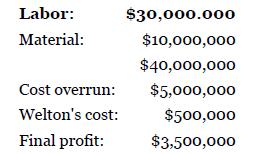Paul was a project management consultant and often helped the Judge Advocate General's Office (JAG) by acting
Question:
Paul was a project management consultant and often helped the Judge Advocate General's Office (JAG) by acting as an expert witness in lawsuits filed by the U.S. government against defense contractors. While most lawsuits were based on unacceptable performance by the contractors, this lawsuit was different; it was based on supposedly superior performance.
Meeting with Colonel Jensen
Paul sat in the office of Colonel Jensen listening to the colonel's description of the history behind this contract. Colonel Jensen stated:
“We have been working with the Welton Company for almost 10 years. This contract was one of several contracts we have had with them over the years. It was a one-year contract to produce 1500 units for the Department of the Navy. Welton told us during contract negotiations that they needed two quarters to develop their manufacturing plans and conduct procurement. They would then ship the Navy 750 units at the end of the third quarter and the remaining 750 units at the end of the fourth quarter. On some other contracts, manufacturing planning and procurement was done in less than one quarter. “On other contracts similar to this one, the Navy would negotiate a firm-fixed-price contract because the risk to both the buyer and seller was quite low. The government's proposal statement of work also stated that this would be a firm-fixed-price contract. But during final contract negotiations, Welton became adamant in wanting this contract to be an incentive-type contract with a bonus for coming in under budget and/or ahead of schedule. “We were somewhat perplexed about why they wanted an incentive contract. Current economic conditions in the United States were poor during the time we did the bidding and companies like Welton were struggling to get government contracts and keep their people employed. Under these conditions, we believed that they would want to take as long as possible to finish the contract just to keep their people working. “Their request for an incentive contract made no sense to us, but we reluctantly agreed to it. We often change the type of contract based on special circumstances. We issued a fixed-price-incentive-fee contract with a special incentive clause for a large bonus should they finish the work early and ship all 1500 units to the Navy. The target cost for the contract, including $10 million in procurement, was $35 million with a sharing ratio of 90%–10% and a profit target of $4 million. The point of total assumption was at a contract price of $43.5 million. “Welton claimed that they finished their procurement and manufacturing plans in the first quarter of the year. They shipped the Navy 750 units at the end of the second quarter and the remaining 750 units at the end of the third quarter. According to their invoices, which we audited, they spent $30 million in labor in the first nine months of the contract and $10 million in procurement. The government issued them checks totaling $49.5 million. That included $43.5 million plus the incentive bonus of $6 million for early delivery of the units. “The JAG office believes that Welton took advantage of the Department of the Navy when they demanded and received a fixed-price-incentive-fee contract. We want you to look over their proposal and what they did on the contract and see if anything looks suspicious.”
Consultant's Audit
The first thing that Paul did was to review the final costs on the contract.
 Welton completed the contract exactly at the contract price ceiling, also the point of total assumption, of $43.5 million.
Welton completed the contract exactly at the contract price ceiling, also the point of total assumption, of $43.5 million.
The cost overrun of $5 million was entirely in labor. Welton originally expected to do the job in 12 months for $25 million in labor. That amounted to an average monthly labor expenditure of $2,083,333. But Welton actually spent $30 million in labor over nine months, which amounted to an average monthly labor cost of $3,333,333. Welton was spending about $1.25 million more per month than planned for during the first nine months. Welton explained that part of the labor overrun was due to overtime and using more people than anticipated. It was pretty clear in Paul's mind what Welton had done. Welton overspent the labor by $5 million and only $500,000 of the overrun was paid by Welton because of the sharing ratio. In addition, Welton received a $6 million bonus for early delivery. Simply stated, Welton received $6 million for a $500,000 investment. Paul knew that believing this to be true was one thing, but being able to prove this in court would require more supporting information. Paul's next step was to read the proposal that Welton submitted. On the bottom of the first page of the proposal was a paragraph titled “Truth of Negotiations,” which stated that everything in the proposal was the truth. The letter was signed by a senior officer at Welton. Paul then began reading the management section of the proposal. In the management section, Welton bragged about previous contracts almost identical to this one with the Department of the Navy and other government organizations. Welton also stated that most of the people used on this contract had worked on the previous contracts. Paul found other statements in the proposal that implied that the manufacturing plans for this contract were similar to those of other contracts and Paul now wondered why two quarters were needed to develop the manufacturing plans for this project. Paul was now convinced that something was wrong.
QUESTIONS
1. What information does Paul have to support his belief that something is wrong?
2. Knowing that you are not an attorney, does it appear from a project management perspective that sufficient information exists for a possible lawsuit to recover all or part of the incentive bonus for early delivery?
3. How do you think this case study ended? (It is a factual case and the author was the consultant.)
Step by Step Answer:

Project Management A Systems Approach To Planning Scheduling And Controlling
ISBN: 9781119805373
13th Edition
Authors: Harold Kerzner





